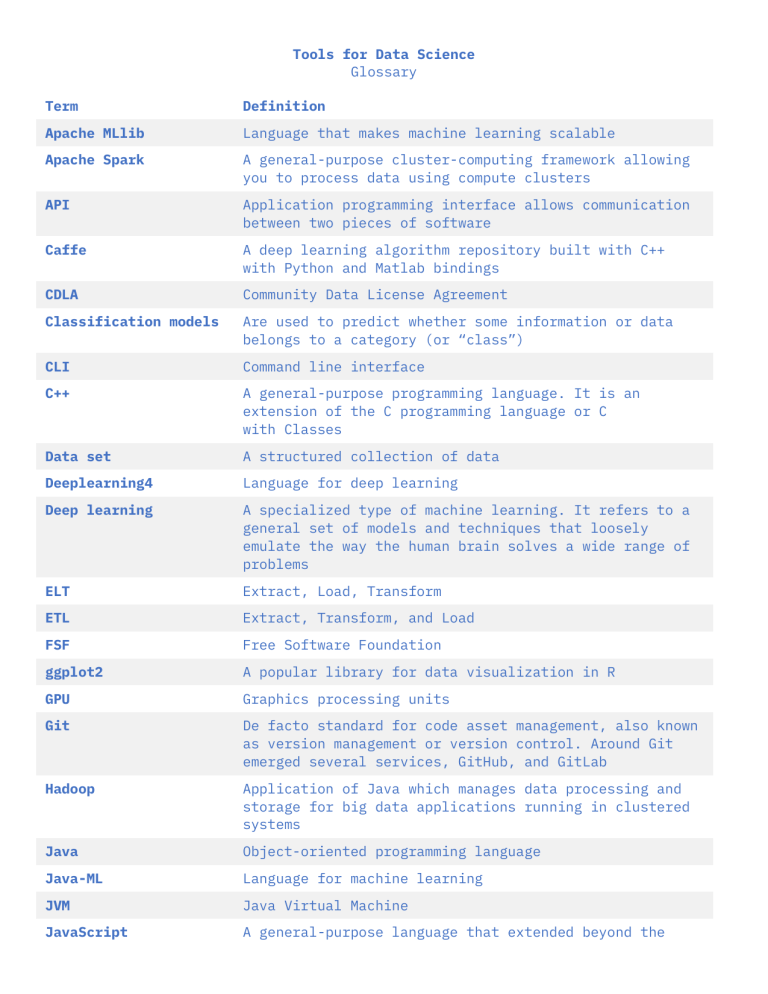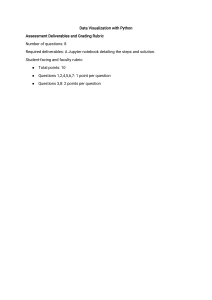
Tools for Data Science Glossary Term Definition Apache MLlib Language that makes machine learning scalable Apache Spark A general-purpose cluster-computing framework allowing you to process data using compute clusters API Application programming interface allows communication between two pieces of software Caffe A deep learning algorithm repository built with C++ with Python and Matlab bindings CDLA Community Data License Agreement Classification models Are used to predict whether some information or data belongs to a category (or “class”) CLI Command line interface C++ A general-purpose programming language. It is an extension of the C programming language or C with Classes Data set A structured collection of data Deeplearning4 Language for deep learning Deep learning A specialized type of machine learning. It refers to a general set of models and techniques that loosely emulate the way the human brain solves a wide range of problems ELT Extract, Load, Transform ETL Extract, Transform, and Load FSF Free Software Foundation ggplot2 A popular library for data visualization in R GPU Graphics processing units Git De facto standard for code asset management, also known as version management or version control. Around Git emerged several services, GitHub, and GitLab Hadoop Application of Java which manages data processing and storage for big data applications running in clustered systems Java Object-oriented programming language Java-ML Language for machine learning JVM Java Virtual Machine JavaScript A general-purpose language that extended beyond the browser with the creation of Node.js and other serverside approaches Julia A language for high-performance numerical analysis and computational science Jupyter Notebook A browser-based application that allows you to create and share documents containing code, equations, visualizations, narrative text links, and more Jupyter Lab A browser-based application that allows you to access multiple Jupyter Notebook files, other code, and data files Kernel An execution environment for the different programming languages Lattice It is a high-level data visualization library that can handle graphics without customizations Library A collection of functions and methods that allow you to perform many actions without writing the code Leaflet Used for creating interactive plots ML Machine learning uses algorithms – also known as “models” - to identify patterns in the data Matplotlib package for data visualization Model training The process by which the model learns patterns from data MNIST Modified National Institute of Standards and Technology MongoDB A NoSQL database for big data management that was built with C++ NLP Natural Language Processing NLTK Natural Language Toolkit NumPy Libraries are based on arrays and matrices, allowing you to apply mathematical functions to the arrays OSI Open-Source Initiative PaaS Platform as a service Pandas A library that offers data structures and tools for effective data cleaning, manipulation, and analysis Plotly Used for web-based data visualizations that can be displayed or saved as individual HTML files PMML Predictive Model Markup Language Python A high-level, general-purpose programming language. It has a large, standard library that provides tools suited to many different tasks, including Databases, Automation, Web scraping, Text processing, Image processing, Machine learning, and Data analytics R A statistical computing language Regression models Are used to predict a numeric (or “real”) value Reinforcement Learning Loosely based on the way human beings and other organisms learn. REST RE stands for Representational; the S stands for State, and the T stands for Transfer RStudio Unifies programming, execution, debugging, remote data access, data exploration, and visualization into one tool SaaS Software as a service Scala Is a combination of scalable and language. A generalpurpose programming language that provides support for functional programming and is a strong static type system Spyder Integrates code, documentation, and visualizations, among others, into a single canvas SQL Structured Query Language that is non-procedural, used for querying and managing data Supervised Learning A learning in which a human provides input data and correct outputs TensorFlow Deep Learning library for dataflow that was built with C++ Unsupervised Learning The data is not labeled by a human. Examples are Clustering models used to divide each record of a dataset into one of a similar group Watson Studio A fully integrated development environment for data scientists Weka Language for data mining

